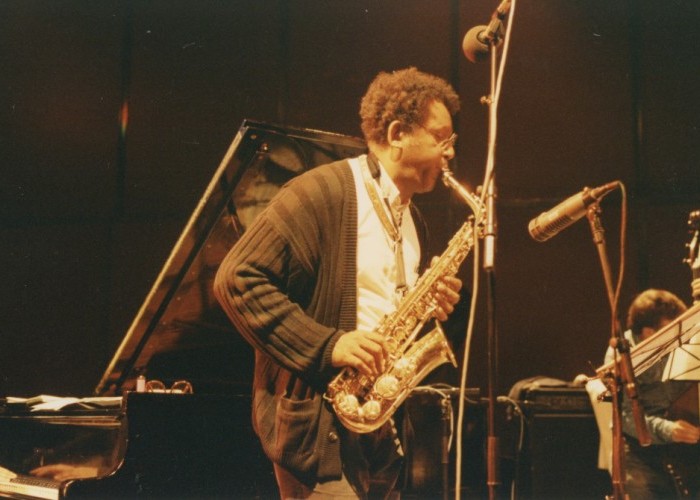Dec 9, 2025 12:28 PM
In Memoriam: Gordon Goodwin, 1954–2025
Gordon Goodwin, an award-winning saxophonist, pianist, bandleader, composer and arranger, died Dec. 8 in Los Angeles.…

Anthony Braxton performs at a 1993 gig that yielded some of the material on Sextet (Parker) 1993.
(Photo: Glenn M. Ito)In the early ’90s, not long after he joined the faculty of Connecticut’s Wesleyan University, Anthony Braxton embarked on a deep dive into the work of Charlie Parker.
The dig wasn’t a difficult one, as Braxton already viewed the compositions and far-reaching solos of the hard-bop pioneer as foundational to everything modern jazz had accomplished to that point. But in the time following the dissolution of his famed quartet with Marilyn Crispell, Gerry Hemingway and Mark Dresser, Braxton dedicated his free time to closely studying Parker’s compositions and the songs he’s associated with, working out new, personalized arrangements of classics like “April In Paris” and “Klactoveedsedstene.”
What resulted from those efforts now can be heard on Sextet (Parker) 1993, a voluminous 11-CD set featuring every note of a recording session and a quick European tour that Braxton and a hand-picked cohort of fellow Bird enthusiasts embarked on 25 years ago. For songs that have been burned into the minds of players and listeners for decades, it is a collection that still is full of surprises, even for some of the musicians who took part in the sessions and performances.
“I didn’t even remember all of the pieces that we did,” said Pheeroan akLaff, the drummer who appears on all but one disc of the new set, which was released by the Tri-Centric Foundation and New Braxton House Records. “Somehow, I thought we only did seven or eight, but we did a lot of different pieces. And we had more that we could have done.”
The sextet, rounded out by bassist Joe Fonda, pianist Misha Mengelberg (who died in 2017), trumpeter Paul Smoker and tenor saxophonist Ari Brown, pulls the easygoing swing of “Bongo Bop” apart like taffy, stretching it out into gnarled fragments. For “Cardboard,” the group gives the song a deconstructed Latin swing, with Braxton leading the way on flute. Elsewhere, on tracks like “Blues For Alice” and “Koko,” they stick close to the template, expanding on these already energetic and bold melodies with grit and flares of dissonance.
What members of this sextet remember most about their experience playing Bird’s tunes with Braxton was how quickly it all came together. True, everyone in the group were veteran players familiar with Parker’s work as part of the jazz canon. But jumping into a collaboration with little or no preparation required a leap of faith.
“I never asked [Braxton], ‘Why me?’” akLaff said. “I had just started teaching drums at Wesleyan, and he immediately said we must do something together. Was it to fulfill some fantasy of working together after knowing each other for so many years? Was I fresh in his mind because I was around the campus? I don’t know. I guess it was important to have the right elements to make this: the right chemistry, the right people, the right music choice.”
The band’s run in Europe was brief, just a handful of shows in Amsterdam, Zurich and Antwerp culminating in a rapid-fire recording session at Großer Sendesaal WDR in Cologne, Germany.
“We had four days in one of the best studios in the world,” Fonda said. “We rehearsed the first day, but otherwise, it all fell into place. Anthony had the charts and everyone was familiar with these tunes; they are all part of us.”
Once the European trip had concluded, the six men went their separate ways, never to perform or tour together in this combination again. That is, in part, why Sextet (Parker) 1993 is such an important document, especially for the artists whose playing it captured on tape.
“I always felt like the luckiest man alive doing that,” akLaff said. “To reflect upon the greatness of one of the masters like Parker with ‘Mister Cutting Edge Braxton’ himself was everything I could have asked for. This wasn’t some jazz club, [where we were] playing a standard or two for people that wanted to tap their foot and smoke cigarettes. This was a huge project.”

Goodwin was one of the most acclaimed, successful and influential jazz musicians of his generation.
Dec 9, 2025 12:28 PM
Gordon Goodwin, an award-winning saxophonist, pianist, bandleader, composer and arranger, died Dec. 8 in Los Angeles.…

Belá Fleck during an interview with Fredrika Whitfield on CNN.
Jan 13, 2026 2:09 PM
The fallout from the renaming of the John F. Kennedy Center for the Performing Arts to include President Donald…

Flea has returned to his first instrument — the trumpet — and assembled a dream band of jazz musicians to record a new album.
Dec 2, 2025 2:01 AM
After a nearly five-decade career as one of his generation’s defining rock bassists, Flea has returned to his first…

The success of Oregon’s first album, 1971’s Music Of Another Present Era, allowed Towner to establish a solo career.
Jan 19, 2026 5:02 PM
Ralph Towner, a guitarist and composer who blended multiple genres, including jazz — and throughout them all remained…

Dec 11, 2025 11:00 AM
DownBeat presents a complete list of the 4-, 4½- and 5-star albums from 2025 in one convenient package. It’s a great…